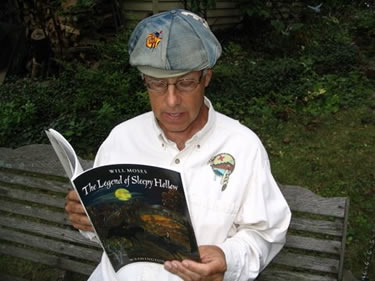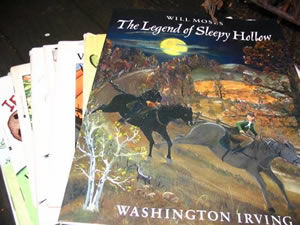Storytelling and the Three R's

“Reading is the fundamental skill upon which all formal education depends. Low reading achievement is the root cause of low performing schools. Reading aloud to children is the single most important activity one can do to raise a reader.”
- U.S. Department of Education
Performance and/or Workshop
Storytelling performances inspire students to love reading. Classroom storytelling activities improve
students reading and writing skills. Workshops help parents, teachers, librarians, and camp counselors
use simple storytelling techniques while reading aloud to children.
Program and Workshop Files
Please copy and give to teachers before assembly or participants before workshop.
You must have Adobe Acrobat Reader installed
to view the program guide.
Visit http://www.adobe.com/products/acrobat/readstep2.html to
download the FREE reader.
Printer friendly version of Performance Flyer: Storytelling and the Three R's Flyer
Storytelling and the Three R’s
Workshop for Parents, Teachers, Librarians, and Camp Counselors
Printer friendly version of Workshop Synopsis: Storytelling and the Three R's: Synopsis of Workshop for Parents, Teachers, Librarians and Camp Counselors
 Abstract
Abstract
Do you read aloud to children? Do you want children to love reading? Do you want to help make the world a better place? Storytelling and the Three R’s can help you achieve these goals with only a small investment of your time. Learn how to improve your reading aloud by using a few simple storytelling techniques that you can also share with children to improve their reading and writing skills. Finally, learn how you can help make the world a better place with a surprise that is almost but not quite, too good to be true!
Goal
To make the world a better place one child at a time by reading aloud and telling stories that inspire love of reading and love of the outdoors.
Objectives
- Participants will practice simple techniques to improve their reading aloud and storytelling abilities.
- Participants will be introduced to storytelling and story writing activities that will improve the reading and writing abilities of their students.
- Participants will learn how they can help make the world a better place.
Keywords
Fun, storytelling, fun, reading aloud, fun, reading, writing, recess, fun, energy, excitement, enthusiasm, fun, re-reading, re-writing, re-enacting, fun, make the world a better place!
Introduction: Storytelling and the Three R’s
Storytelling is an art that is making the world a better place one child at a time because it enables the teller to tickle the funny bone, tingle the spine, teach the mind, and touch the heart of each listener in a special way because no two people ever hear exactly the same story. Best of all, storytelling is a folk art not a fine art and that is a very good thing because folk artists are allowed to make mistakes! That’s especially important if you’re new to storytelling and afraid to get started. As for the three R’s…we all know that they are… reading, ‘riting, and my favorite, RECESS!!!
Reading Aloud Just for the Love of It
Now that we’ve covered the basics, it’s time to have some fun. Are you ready for some fun? Are you excited? Beats being in a faculty meeting…right? This is a story by Robert Fulghum, the author of All I Really Need to Know I Learned in Kindergarten. This is a story from Maybe (Maybe Not) called The Ape and the Naked Lady. Read story aloud. Did you like that story? What did you like about that story? Why?
People do things they like. If we want children to read more they must like reading. How do we get children to like reading? We read aloud to them! And our reading embodies the three E’s: Energy, Excitement, and Enthusiasm so that our read aloud stories are full of the three F’s. You know what the three F’s are of course… FUN, FUN, FUN.
Okay, back to the three R’s. They are a bridge between reading aloud and storytelling. This time I’m talking about: Re-reading, Re-writing, and Re-enacting.
First: re-reading. Most of you probably read your favorite stories over and over. You know which parts of a story children like the best. You’re already well on your way to becoming storytellers.
Second: re-writing. Using a pencil, lightly underline the favorite parts of your story. Or, if you just can’t bring yourself to write in your book, make a copy of the story and then underline the best parts.
Third: re-enacting. Read the edited version of your story silently several times. Next, infuse your story with the three E’s and the three F’s while reading it aloud several times until you really, really know it well. In other words, the three P’s: practice, practice, practice but DON’T MEMORIZE!
Finally: The three T’s. You’re ready, way past ready in fact, to Teach a mind, Touch a heart, TELL a story. Tell it silently, tell it aloud, tell it to friends, tell it to family members, and tell it to children! And don’t forget…storytelling is a folk art, so it’s okay to make mistakes, just go with it and make the story yours, and let the magic happen.
Three Minute Tales (small group activity)
Everyone find a partner.
If you brought along a favorite story, re-write part of it by underlining the good parts with a pencil. Try to keep the edited version to three minutes, but don’t take out vital information or good parts of the story. If it’s a long story just pick one chapter or about five minutes worth of reading. If you didn’t bring a story I have a few that you can try. When you are done re-writing your story, take turns reading it aloud to your partner.
If it’s a story you’re already very familiar with, try telling it to your partner.
Bring everyone back into one big group. How did it go? Did any of you try telling your story? “Never be afraid to try something new: remember, a lone amateur built the ark, a large group of professionals built the Titanic.” Just start with one good, short story that you love. You’re probably too busy to learn very many stories, but that’s okay because you don’t ever want to stop reading aloud since that’s how children are going to learn to love reading!
Student Storytelling Activities to Improve Reading and Writing Skills
Circular storytelling-start a story and then hand it off until everyone has a turn.
Circular story writing-everyone starts writing a story on a separate page then pass the pages and add a sentence until story returns to originator.
Combine circular writing and telling-write first then tell.
Writing and telling tall tales-see additional information.
Making the World a Better Place
Do you love the outdoors? Why? Did you always love the outdoors? How did your love of nature and the outdoors come about? What happened in your life to spark your love of the outdoors? If it only takes a spark to get a fire going, what can you do to spark children’s love of the outdoors?
Surveys of adults show that the number one reason people give for loving nature and wanting to help take care of the earth is that they had lots of opportunities to simply have fun in the outdoors as children. One of the things we can do to help make the world a better place is to give children the same opportunities to have fun in the outdoors as we had. Outdoor fun is number one!!! This brings us back to one of the original three R’s, RECESS!
If your students love recess, and if they love when you read aloud to them, then you can help save the earth simply by reading aloud to them outside. Just do it right after recess so it won’t take any extra time going in or out. And if you want to make an even bigger impact, try restoring a small part of your school yard with native plants to provide a small area where your class can be surrounded by nature while you read aloud to them.
Conclusion
Finally, I’d like to end by telling you a story about how I came to love reading and to love the outdoors. As you may have guessed, it had a lot to do with having fun when I was young. It all started when I was little: a long, long time ago when I was lucky enough to visit my Uncle Arnold and Aunt Lucille on the farm every summer…
Tell story: The Snake Bit Hoe Handle or The Best Little Hen House in Minnesota.
One last thing, I need your help to accomplish the goal of making the world a better place one child at a time by reading aloud and telling stories that inspire love of reading and love of the outdoors. Please help. Read aloud outdoors! Outdoor fun is number one!
Resources:
- Learning from the Land, by Brian “Fox” Ellis
- Jim Walser, Chicago Region Interpreters, (630) 968-3209
- www.cricketshows.com
Printer Friendly PDF Files Available
Program Flyers
- Christine Buik Programs
- Christine Buik High School Programs
- Christine Buik Adult Programs
- Jim Walser: Story-n-Actor
- Jim Walser Adult Programs: Storytelling and the Three R's
Program Study Guides
- Animal Inventors - Presented by Christine Buik
- Dinosaur Discoveries - Presented by Christine Buik
- Earth Day Every Day - Green Lifestyles - Presented by Jim Walser
- Earthkeepers - Presented by Christine Buik
- It's a Jungle Out There - Substance Abuse Program - Presented by Christine Buik
- It's a Jungle Out There - Animals Only Program - Presented by Christine Buik
- Storytelling and the Three R's: Synopsis of Workshop for Parents, Teachers, Librarians and Camp Counselors
- Teach the Mind, Touch the Heart - Character Education - Presented by Jim Walser
- The Journey Starts Now - Presented by Christine Buik
*Schools: Check with your District Office...It’s a Jungle Out There (substance abuse program) qualify for Safe & Drug-Free Entitlement Money authorized by the State Board of Education.
